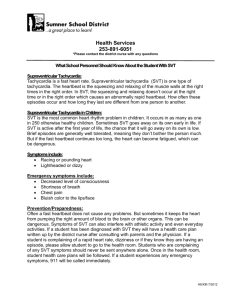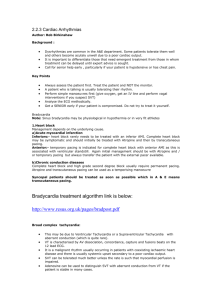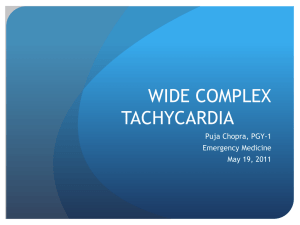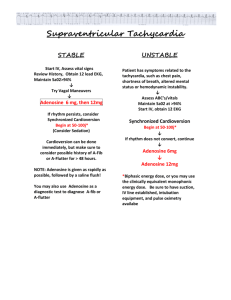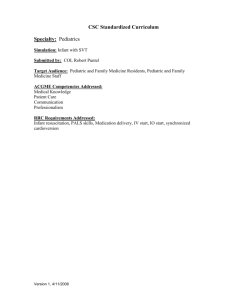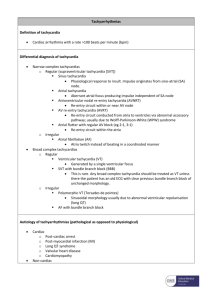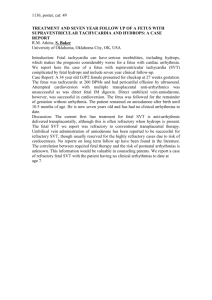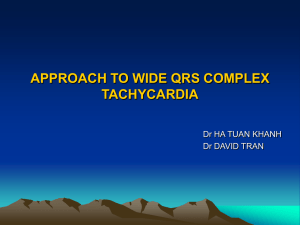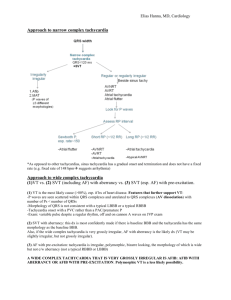Pediatric Supraventricular tachycardia - SIM-one
advertisement
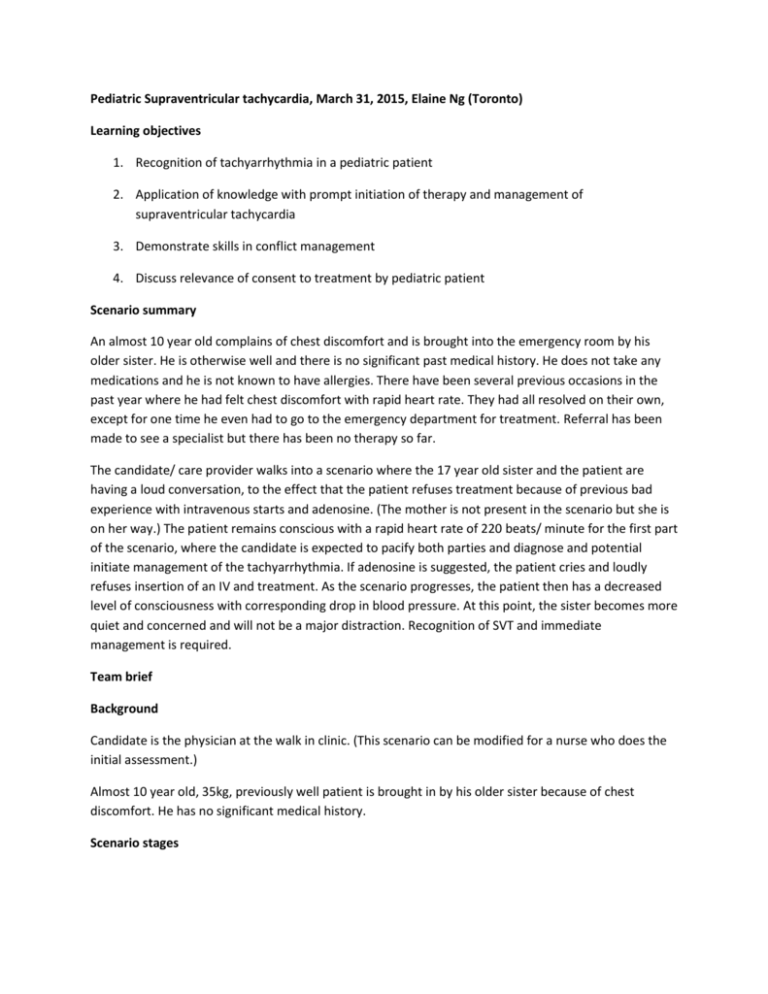
Pediatric Supraventricular tachycardia, March 31, 2015, Elaine Ng (Toronto) Learning objectives 1. Recognition of tachyarrhythmia in a pediatric patient 2. Application of knowledge with prompt initiation of therapy and management of supraventricular tachycardia 3. Demonstrate skills in conflict management 4. Discuss relevance of consent to treatment by pediatric patient Scenario summary An almost 10 year old complains of chest discomfort and is brought into the emergency room by his older sister. He is otherwise well and there is no significant past medical history. He does not take any medications and he is not known to have allergies. There have been several previous occasions in the past year where he had felt chest discomfort with rapid heart rate. They had all resolved on their own, except for one time he even had to go to the emergency department for treatment. Referral has been made to see a specialist but there has been no therapy so far. The candidate/ care provider walks into a scenario where the 17 year old sister and the patient are having a loud conversation, to the effect that the patient refuses treatment because of previous bad experience with intravenous starts and adenosine. (The mother is not present in the scenario but she is on her way.) The patient remains conscious with a rapid heart rate of 220 beats/ minute for the first part of the scenario, where the candidate is expected to pacify both parties and diagnose and potential initiate management of the tachyarrhythmia. If adenosine is suggested, the patient cries and loudly refuses insertion of an IV and treatment. As the scenario progresses, the patient then has a decreased level of consciousness with corresponding drop in blood pressure. At this point, the sister becomes more quiet and concerned and will not be a major distraction. Recognition of SVT and immediate management is required. Team brief Background Candidate is the physician at the walk in clinic. (This scenario can be modified for a nurse who does the initial assessment.) Almost 10 year old, 35kg, previously well patient is brought in by his older sister because of chest discomfort. He has no significant medical history. Scenario stages Initial state – sinus rhythm, HR 220, BP 90/60, RR 20, Temp 36, O2 sat 100%, crying and talking loudly and arguing with the sister. The patient did not want to be taken to the emergency room because of previous “awful treatment”. At about 7 minutes (regardless whether the candidate is successful or not in pacifying both parties) – SVT HR 220, BP 72/30, RR 26, Temp 36, O2 sat 100% and gradually decrease to about 93-94%, no sound from patient (not responsive) The scenario is limited to 12 minutes: 1. If they give adenosine – brief (2 second) sinus rhythm HR 90, then back to SVT 2. If they cardiovert – they would have to consider giving some sedation Recovery – sinus rhythm, HR 160, BP 100/60 (after 1-2 attempts with each of the therapies mentioned above) Equipment Sim Junior (Laerdal) Name band, patient folder Monitoring equipment: ECG, NIBP, O2 sat. No ETCO2 Airway equipment: facemask, guedel airway, Oxygen source and flow inflating bag, LMA #3.0, laryngoscope, endotracheal tube size 6.0 cuffed, suction IV access equipment: Angiocath 22g, dressing, IV fluids with drip Medications: Succinylcholine, atropine, midazolam, morphine, Propofol, adenosine, amiodarone, saline flushes, 3 way stopcock Other: bag of ice Personnel Candidate: Physician on duty Supporting personnel: RN, sister, voice of patient Background evidence for scenario Supraventricular tachycardia (SVT) is an abnormally fast rhythm originating above the ventricles. It is most commonly caused by a reentry mechanism that involves an accessory pathway or the AV conduction system. It is the most common narrow complex tachyarrhythmia in children. It may be present but undetected for long periods of time until there is cardiac compromise. Common signs and symptoms in SVT include irritability, poor feeding, rapid breathing, cyanosis and decreased level of consciousness. Older children may complain of palpitations, shortness of breath, chest discomfort or dizziness. It should be differentiated from sinus tachycardia. Evaluation by an ECG, and the clinical presentation and history should be helpful. If the rhythm is sinus tachycardia, reversible causes should be sought and treated. The cardiogram in SVT typically shows no beat to beat variability with activity, absent or abnormal P waves, PR interval cannot be determined, RR interval is often constant, and the QRS complex is usually narrow with more than 90% of cases less than ≤0.09second. For a hemodynamically stable patient, vagal manoeuvres can be used as the initial management for SVT. This may include application of ice to the face without occluding the airway in infants and young children. An older child may be able to follow commands and can blow against an unobstructed straw. In older children, carotid sinus massage can also be used. Medications Pharmacologic cardioversion with adenosine is very effective and with transient side effects. Adenosine blocks conduction through the AV node temporarily for about 10 seconds. This is administered IV/ IO. The dose is 0.1mg/kg and should be rapidly administered. This can be achieved by using 2 syringes connected to a T-connector or stopcock, adenosine is given rapidly with 1 syringe and immediately flushed in with normal saline. If there is a choice of IV site, the medication should be administered as close to the heart as possible. Verapamil 0.1-0.3mg/kg is also effective in termination of SVT in older children. Its use is not routinely recommended for infants due to potential for myocardial depression, hypotension and cardiac arrest. Amiodarone and procainamide may be considered if the patient is unresponsive to vagal manoeuvres, pharmacologic or electric cardioversion. Expert consultation should be sought at this point, especially in hemodynamically stable patient. Adenosine may be useful in differentiating SVT from ventricular tachycardia and converting wide complex tachycardia of supraventricular origin. This medication should only be considered if the rhythm is regular and the QRS is monomorphic. Synchronized cardioversion If the patient is hemodynamically unstable, or adenosine is ineffective, synchronized cardioversion should be performed. Consider use of sedatives if possible. Start at 0.5-1J/kg, if unsuccessful can increase to 2J/kg. Amiodarone or procainamide may be considered if the patient is unresponsive to the second shock or the tachycardia recurs quickly. Rational for the simulation scenario SVT is a common tachyarrhythmia in children and the management should be reviewed in a simulated setting for observation of certain tasks (diagnosis, administration of adenosine, cardioversion). A variation of this scenario has been used many times in teaching sessions at our tertiary care hospital. For the sake of completeness and review, the arrhythmia is not terminated until all the various medical and electrical therapies have been at least considered if not attempted. Candidates should also proactively request for airway and resuscitation equipment in anticipation for instability. This scenario also includes a non-technical skill. The care provider will be distracted enough that he/she will have to pacify the two parties and demonstrate skills in conflict management. Consideration has to be given to a pediatric patient who clearly refused treatment but is not of legal age for consent. Literature search strategy Pubmed, OVID Supraventricular tachycardia and central venous catheter, SVT and guidewire, SVT resuscitation, SVT and operating room References Kleinman ME. Part 14: Pediatric Advanced Life Support. 2010 American Heart Association Guidelines for Cardiopulmonary Resuscitation and Emergency Cardiovascular Care. Circulation 2010; 122: S867-908 Biarent D. European Resuscitation Council Guidelines for Resuscitation 2010. Section 6. Paediatric life support. Resuscitation 2010; 81: 1364-1388 Elsharkawy H. Post placement positional atrial fibrillation and peripherally inserted central catheters. Minerva Anestesiol 2009; 75: 471-4 Manole MD. Emergency department management of the pediatric patient with supraventricular tachycardia. Pediatric Emergency Care 2007; 23: 176-189
